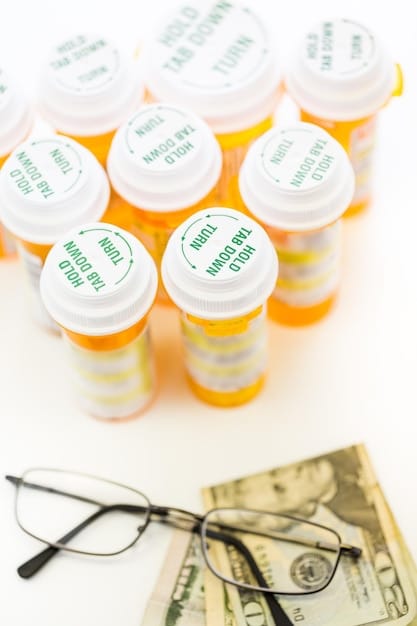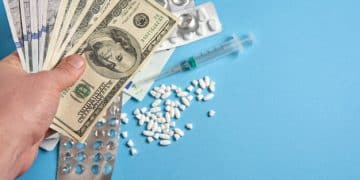Prescription Drug Costs: Save Up to 30% on Meds in 2025

Prescription drug costs are a significant concern for many Americans. By utilizing strategies such as comparing prices, exploring generic options, and leveraging patient assistance programs, individuals may potentially save up to 30% on prescription drug costs in 2025.
Navigating the landscape of prescription drug costs can feel overwhelming, especially with ever-changing healthcare policies and rising medication prices. Many individuals are looking for ways to lower costs. The good news is there are strategies to potentially save up to 30% on medications in 2025.
This guide will explore practical tips and resources that empower you to take control of your healthcare expenses, making vital medications more affordable in the coming year. From understanding insurance options to exploring discount programs, you’ll discover actionable advice to reduce prescription drug costs.
Understanding the Factors Driving Prescription Drug Costs
Several factors contribute to the high cost of prescription drugs in the United States. Understanding these factors can help you advocate for lower prices and make informed decisions about your healthcare.
The Role of Pharmaceutical Companies
Pharmaceutical companies invest heavily in research and development of new drugs. They often justify high prices to recoup these investments and fund future innovations. However, the level of profit companies make is often scrutinized in discussions about prescription drug costs.
The Impact of Insurance Companies and Pharmacy Benefit Managers (PBMs)
Insurance companies and PBMs negotiate drug prices and manage formularies (lists of covered drugs). Their negotiations can impact the prices consumers pay, but the complexity of these negotiations often leads to high prescription drug costs for individuals.
- Negotiating power: PBMs and insurance companies attempt to lower prices, but their effectiveness varies.
- Formulary design: The drugs included in a formulary can significantly affect out-of-pocket costs.
- Rebates and discounts: These are not always passed on to consumers.
Generic vs. Brand-Name Drugs
Brand-name drugs typically have patent protection, allowing the manufacturer to set prices without competition. Once the patent expires, generic versions can enter the market, often at significantly lower prices. Choosing generic medications is one key way to save up to 30% on medications in 2025 and beyond.
Understanding the complex interplay of pharmaceutical companies, insurance providers, and generic drug availability is crucial for navigating the healthcare system effectively.

Strategies to Save on Prescription Drug Costs: How to Save Up to 30% on Medications in 2025
Individuals can use many effective strategies to manage and potentially lower their prescription drug costs. These range from exploring insurance options to leveraging discount programs.
Review Your Insurance Coverage
Take time to understand the specifics of your health insurance plan. This includes knowing your deductible, co-pay, and co-insurance amounts. Also, be aware of which medications are covered under your plan’s formulary. If your medication isn’t covered, consider discussing alternatives with your doctor.
Consider Generic Alternatives
Whenever possible, opt for generic medications. Generic drugs contain the same active ingredients as their brand-name counterparts but are typically much cheaper. Ask your doctor if a generic version is available for your prescription.
Prescription Drug Costs: How to Save Up to 30% on Medications in 2025 by Comparing Prices
Prices for the same medication can vary significantly between pharmacies. Use online tools or call different pharmacies to compare prices. Some pharmacies may also offer price-matching programs or discounts.
- Online price comparison tools: Websites can help you find the lowest prices in your area.
- Local pharmacy price checks: Call pharmacies to inquire about their prices.
- Mail-order pharmacies: These can sometimes offer lower prices and convenience.
Prescription Drug Costs: Patient Assistance Programs
Many pharmaceutical companies offer patient assistance programs (PAPs) that provide medications at reduced or no cost to eligible individuals. Eligibility criteria usually include income limits and lack of insurance coverage.
Look for Discount Cards and Programs
Numerous discount cards and programs are available, often free of charge. These cards can provide discounts on prescription drugs at participating pharmacies. Some organizations also offer membership programs with added benefits.
Implementing a combination of these strategies can significantly alleviate the burden of high prescription drug costs, helping you achieve potential savings. By comparing prices, using generic medications and exploring patient assistance programs, everyone can begin to effectively save up to 30% on medications in 2025.

The Future of Prescription Drug Costs
The landscape of prescription drug costs is constantly evolving, influenced by regulatory changes, technological advancements, and market dynamics.
Legislative and Regulatory Changes
Governmental policies, such as the Inflation Reduction Act, aim to lower prescription drug costs by allowing Medicare to negotiate drug prices directly with pharmaceutical companies. Monitor these changes, as they could impact your future medication expenses.
The Role of Technology and Telehealth
Telehealth and digital health technologies can play a role in reducing prescription drug costs. For example, online pharmacies and telemedicine consultations may offer more competitive pricing and convenient access to healthcare. Using apps to compare the price of prescription drug costs is an easy way to start saving up to 30% on medications in 2025.
Personalized Medicine and its Potential Cost Implications
Personalized medicine, which tailors treatment to an individual’s genetic makeup, has the potential to improve treatment outcomes. However, these therapies can be very expensive. Consider the long-term benefits and potential costs when exploring these options.
- Improved treatment outcomes: Personalized medicine can lead to more effective treatments.
- Potential for higher upfront costs: These treatments may come at a premium.
- Long-term savings: More effective treatments can reduce the need for additional interventions.
Staying informed about legislative actions, technological advancements, and personalized medicine can help you prepare for future changes in prescription drug costs. By keeping abreast of these developments, everyone can proactively prepare for prescription drug costs in the future by starting to save up to 30% on medications in 2025.
The Impact of Lifestyle Choices on Medication Needs
While medications are vital for managing many health conditions, lifestyle choices can also significantly impact your overall health and potentially reduce your reliance on medications. The better one’s lifestyle, the less one may need to worry about prescription drug costs.
The Role of Diet and Exercise
Adopting a healthy diet and engaging in regular exercise can help prevent and manage chronic conditions such as diabetes, heart disease, and obesity. These lifestyle changes can lead to a reduced need for medications and, therefore, lower prescription drug costs.
Stress Management Techniques
Chronic stress can exacerbate certain health conditions and increase the need for medications. Practicing stress management techniques such as meditation, yoga, or deep breathing exercises can improve your overall well-being and potentially reduce medication usage.
The Importance of Preventative Care
Regular check-ups and screenings can help detect health issues early, before they require extensive and costly treatment. Vaccinations and preventative medications can also reduce the risk of developing certain diseases, leading to lower healthcare costs overall.
By prioritizing lifestyle choices that promote health and well-being, you can potentially reduce your reliance on medications and lower your overall healthcare expenses. While taking steps now to improve your lifestyle, remember these strategies to help save up to 30% on medications in 2025.
Long-Term Planning for Prescription Drug Costs
Planning for long-term healthcare expenses, including prescription drug costs, is essential for financial security. By integrating prescription drug costs into one’s financial plan, individuals can take the worry of prescription drug costs out of their mind.
Health Savings Accounts (HSAs)
If you have a high-deductible health insurance plan, consider opening a Health Savings Account (HSA). HSAs allow you to save pre-tax dollars for healthcare expenses, including prescription drugs. The money in an HSA grows tax-free and can be used to pay for qualified medical expenses at any time.
Medicare Part D and Supplemental Insurance
If you are eligible for Medicare, enroll in Medicare Part D to help cover prescription drug costs. Consider purchasing supplemental insurance to fill in gaps in coverage and lower your out-of-pocket expenses.
Prescription Drug Costs: Reviewing Long-Term Care Insurance
Long-term care insurance can help cover the costs of prescription drugs and other healthcare services if you require long-term care. This insurance can provide financial protection and peace of mind as you age.
Planning for long-term healthcare expenses can help you prepare for the future and protect your financial well-being. By incorporating strategies like using HSAs, enrolling in Medicare Part D, and considering long-term care insurance, you can have the knowledge to save up to 30% on medications in 2025.
| Key Point | Brief Description |
|---|---|
| 💡 Generic Drugs | Opt for generics; they offer the same active ingredients at a lower price. |
| 💰 Price Comparison | Compare prices across pharmacies using online tools or direct calls. |
| 🤝 Assistance Programs | Explore patient assistance programs for reduced medication costs. |
| ⚕️ Lifestyle Choices | Healthy habits contribute to wellness and lower reliance on medications. |
Frequently Asked Questions
Begin by comparing prices at different pharmacies, asking your doctor about generic alternatives, and exploring patient assistance programs offered by pharmaceutical companies to help manage prescription drug costs.
Effective strategies include reviewing your insurance coverage, using discount cards, and discussing therapeutic alternatives with your healthcare provider to ensure you’re getting the most cost-effective treatment.
Yes, generic drugs contain the same active ingredients as brand-name drugs and are required to meet the same safety and efficacy standards, often providing significant savings without sacrificing quality.
A Health Savings Account (HSA) is a tax-advantaged savings account that can be used to pay for eligible healthcare expenses, including prescription drugs, offering a way to save pre-tax dollars for medical needs.
Adopting healthy lifestyle choices such as a balanced diet, regular exercise, and stress management techniques can improve overall health and may reduce the need for certain prescription medications, saving up to 30%.
Conclusion
Managing prescription drug costs requires a multi-faceted approach, starting with awareness and informed decision-making. By exploring various savings opportunities and adopting proactive planning strategies, everyone can find ways to take control of their healthcare expenses.
Staying informed, advocating for yourself, and leveraging available resources can alleviate the burden of high prescription drug costs and ensure access to the medications you need for a healthy life. You can begin to save up to 30% on medications in 2025 today.





